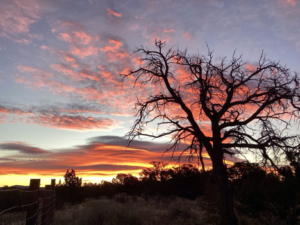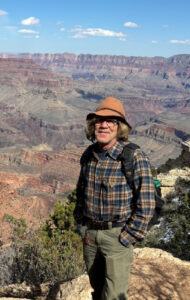 The dead pinyon pine behind my shack still looks sturdy. For now, at least.
The dead pinyon pine behind my shack still looks sturdy. For now, at least.
Short and stout in the way of its kind, the tree is more than a foot in diameter, but just 25 feet tall. When I bought this place ten years ago it was almost dead, battered by the one-two punch of drought and beetles.
It finally gave up the ghost during an especially dry summer a few years ago. I had planned to cut up the tree for firewood–pinyons make dense and fragrant fuel–but changed my mind. Why? Because I could only burn the thing once. After it had warmed the house for a few nights, all that would remain is a bucket of ash.
But if I leave the tree where it is, I can step out my door and look at it as often as I’d like – for years, maybe decades, to come. And though some might disagree, a dead tree is not by definition an ugly tree.
Tonight, the pinyon pine is silhouetted by a lurid Arizona sunset that rakes across the sky in metallic orange, salmon pink and turquoise. Its naked branches reach skyward, like the arms of a Pentecostal preacher on Sunday morning.
From my lawn chair by the door on the east side of the cabin, I watch a chipmunk busy itself in the ground litter – doing what, I can’t imagine. It’s been a decade since this tree produced a nut.
Still, the dead pine has a sort of life ahead of it. In the dry climate of northern Arizona, the thing may stand for another 20 or 30 years, attracting countless bluebirds, woodpeckers, and jays – both the aptly named pinyon jay, and its larger, more raucous cousin, the Steller’s jay.
The neighborhood ravens will park in its upper branches nearly every day, scolding me for not leaving something outside for them to steal. And who knows? I may look out the south window one morning to see a flock of vultures perched on the dead tree, waiting for somebody’s misfortune (mine?) to become their good luck.
Tonight, two small, anonymous songbirds find roosts at the top. They don’t sing, though, just chirp out a tentative question or two then fall silent. Whatever answers arrive on the autumn wind must have something to do with leaving for somewhere warmer. Soon.
For those of us who stay the winter, this time of year is for building a woodpile. But there’s no need to saw up the dead tree – all the firewood I’ll ever need can be found on the national forest lands that surround my place.
Instead of becoming fuel, the dead pine is now a cohabitant and partner in the project I’ve started out here, 40 miles from town. After decades of here, there and everywhere, I have settled in the boonies south of Grand Canyon. This windswept acre is the first home I’ve ever owned – and the last one I’ll ever need, I hope.
Most people buy cheap land out here for the quiet, and the views: the sun-splashed, arid plateau sweeps out for 20 or 30 miles in all directions. A few buyers build, but most simply drag out an old camper, stay in it a couple times a year, then lose interest. The lots go for back taxes.
Maybe I’ll lose interest, too, but I don’t think so. My tiny house has big windows on all four walls, and a two-digit annual tax bill. Along with the woodstove there is solar power and rainwater collection, raised-bed gardens, a greenhouse and sauna.
After a decade in this place, my fascination with it only grows. So does my gratitude. The march of seasons endlessly reveals new beauty. Each day the sun rises and sets over my enormous good luck.
Tonight as darkness falls, I rise from the chair and head inside. Just as I close the cabin door an owl hoots from the old dead tree and I congratulate myself for letting it stand.
In time, of course, the tree out back will fall to the ground and rot. That too should be interesting, if I’m around to see it. There are no guarantees. Both the tree and I are on our separate ways back to the earth, to become new life. Which of us gets there first is anyone’s guess.

